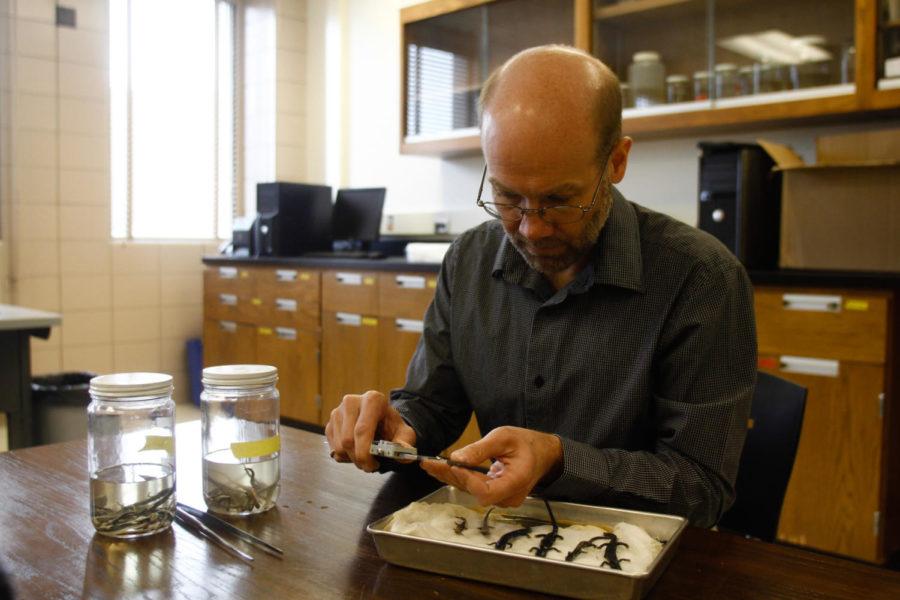Climate change affects salamander size, professor studies environmental impact on growth of organism
Tomhas Huhnke/Iowa State Daily
Dean Adams, a professor at Iowa State, examines the Appalachian salamander species in his research laboratory on March 31, 2014. Adams has noted shrinking in the salamanders, who have lost an average of 7 percent of their body size in recent decades.
April 2, 2014
An ISU professor is looking into the effects of climate change on the size of salamanders.
The influence of climate change on the growth of salamanders is particularly concerning to scientists because amphibians respond earlier to environmental changes.
Dean Adams, professor of ecology, evolution, and organismal biology, had data from a collection of preserved salamanders to contribute to a study done by Karen Lips, associate professor of biology at the University of Maryland.
The study conducted included 15 species of salamanders from 102 populations. These species all belonged to the genera, Plethodon.
Lips found that six species showed significant reductions in body size over 55 years.
Lips and her colleagues started noticing a decline in salamander populations located in the Appalachian Mountains area. Lips initially thought that the decline in population would be due to a disease outbreak. Yet, when they went out to sample for disease, they couldn’t find any such diseases that would have such a widespread effect on salamander population.
“Climate change is the only thing that could affect such large populations,” Lips said.
These particular salamanders that were studied have no lungs. They are also ectothermic, meaning their internal heat is reflective of the temperatures of their environment.
Adams said that amphibians are good bellwether organisms for indications of changes in the environment, because amphibians are responding, and scientists can see that the environment is going through major changes that they need to pay attention to.
“When the temperature goes up, all normal processes speed up, burning calories faster. Ectothermic organisms need to eat more and increase the amount of calories,” Lips said.
A colleague studied the salamanders’ physiology and found that they are using eight percent more energy on internal maintenance rather than energy on growth, Adams said.
In order to sample the salamanders, Lips and her colleagues visited each site in the Appalachian region three times, during the summer, spring and fall. They caught every animal under rocks and measured and weighed them, as well as tested for diseases.
While they had current data about the physiological states of salamanders, Lips and her colleagues didn’t have any historical data to compare their findings to. Luckily, Adams had data representing salamander physiology dating back 60 years.
Professor Emeritus Richard Highton from the University of Maryland had been collecting and preserving these salamanders from the Appalachian region since the 1950s.
A major reason why Lips had conclusive evidence was because there was such a large data set available in the archives of the Smithsonian.
Adams said that Highton was trying to understand the taxonomy and natural history of the salamanders. Through his work, Highton discovered several different species of salamanders.
Adams used these salamanders that were preserved and kept at the Smithsonian Museum in Washington D.C., for a different project. He often made trips to the museum as well as having specimens sent to him.
A way to further the study would be to look at salamander sizes living in different regions of the United States. Adams is continuing his collaboration to build the study.







